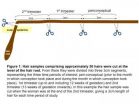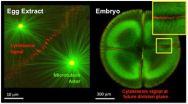Immune cells proposed as HIV hideout don't last in primate model
Macrophages short-lived in SIV infected primates
2014-10-31
(Press-News.org) Where does HIV hide? Antiretroviral drugs can usually control the virus, but can't completely eliminate it. So any strategy to eradicate HIV from the body has to take into account not only the main group of immune cells the virus targets, called CD4 or helper T cells, but other infected cells as well.
New research from Yerkes National Primate Research Center, Emory University, sheds light on the question of which cells support viral replication and persistence, and the answers have implications for future efforts to eliminate HIV from the body in human patients.
The results are scheduled for publication today in the journal PLOS Pathogens.
"Our results have implications for efforts to cure HIV," says lead author Mirko Paiardini, PhD, assistant professor of pathology and laboratory medicine at Emory University School of Medicine and Yerkes National Primate Research Center. "Our findings suggest that therapeutic strategies aimed at stimulating infected macrophages may facilitate viral elimination."
Researchers at Yerkes looked at what happens when rhesus macaques have CD4 T cells removed from their immune systems before infection by HIV's cousin SIV. They found that another type of immune cell, called macrophages, then becomes heavily infected by SIV. Infected cells are present in lymph nodes, intestine and brain as well as in the blood.
However, the macrophages live shorter than expected based on previous research studies, which calls into question the idea that the macrophages could serve as a long-term hideout when someone is infected by HIV but receiving antiretroviral drugs.
"Among HIV researchers, there has been a lot of debate about the contribution of macrophages to the HIV reservoir," Paiardini says. "We show that in the absence of CD4 T cells, macrophages can be heavily infected by SIV, which supports a role for macrophages in viral infection. However, when infected at high levels, macrophages become short-lived cells in vivo, with an average lifespan of 1.3 days. Thus, if validated in the setting of HIV infection in humans, our data support a model in which macrophages do not constitute the long-lived reservoir (in order of weeks) that has been proposed.
The researchers also found evidence that in macaques with depleted CD4 T cells, SIV is infecting microglial cells in the brain, otherwise rarely seen.
INFORMATION:
Co-first authors were postdoctoral fellow Luca Micci, PhD and Robin Iriele from Yerkes and Xavier Alvarez from Tulane. Yerkes co-authors included Guido Silvestri, MD, and Cynthia Derdeyn, PhD, and collaborators from Tulane University, the National Cancer Institute and the University of New South Wales contributed to the paper.
ELSE PRESS RELEASES FROM THIS DATE:
2014-10-31
The pathogen Giardia duodenalis is present in mussels from freshwater run-off sites and from areas where California Sea Lions lounge along the coast of California, according to a team of researchers from the University of California, Davis. One of the G. duodenalis strains found is known to infect humans; the two others occur mostly in dogs and other canids. "Thus, the detection of these assemblages implies a potential public health risk if consuming fecally contaminated water or uncooked shellfish," says coauthor Woutrina Smith. The research is published ahead of print ...
2014-10-31
Today the leading journal PLOS ONE published research that provides underlying scientific support for a fundamentally new type of natural alternative to the use of antibiotics in livestock feeds for growth promotion and disease prevention. The paper is the result of work by both independent and company scientists. Avivagen Inc. is a wellness company developing and delivering products that support and enhance the health and quality of life for animals and the people who care for them.
The discovery that the product formed by full, spontaneous oxidation of beta-carotene, ...
2014-10-31
Drug tests on 517 mothers in English inner city hospitals found that nearly 15% had taken recreational drugs during pregnancy and that mothers of babies with birth defects of the brain were significantly more likely to have taken drugs than mothers with normal babies. The study found no significant links between recreational drug use and any other type of birth defect.
The study was led by a team of UCL researchers co-ordinating data collection from hospitals across London, Bristol and Birmingham and the results are published in the journal PLOS ONE. The study included ...
2014-10-31
It is up to 30 centimetres long, it has a green-brown color and is probably known to every beach walker on the North and Baltic Sea: the bladderwrack, a seaweed, which is common on the coasts of the whole North Atlantic area. The bladderwrack provides food and habitat for many other organisms. Its abundance is considered to be an indication of whether a coastal ecosystem is intact or not. Especially in the German Baltic Sea, however, the populations have declined considerably in the past decade. The reasons for this are not yet fully known. "Against this background, it ...
2014-10-31
Four minutes of physical activity can improve behaviour in the classroom for primary school students, according to new research by Brendon Gurd.
A brief, high-intensity interval exercise, or a "FUNterval," for Grade 2 and Grade 4 students reduced off-task behaviours like fidgeting or inattentiveness in the classroom.
"While 20 minutes of daily physical activity (DPA) is required in Ontario primary schools, there is a need for innovative and accessible ways for teachers to meet this requirement," says Dr. Gurd, lead researcher and professor in the School of Kinesiology ...
2014-10-31
In the early 1900s, Brazil was the world's largest producer of cocoa. Chocolate trees (Theobroma cacao) were cultivated in a 800, 000 ha region of rainforest in the state of Bahia, beneath a dense canopy of native shade trees. Whereas the surrounding rainforest was a biodiversity hotspot, the chocolate trees, which were derived mainly from a handful of seeds introduced in the mid 1700s, had very low levels of genetic variation. According to Brazilian scientist Gonçalo Pereira, "This scenario created a very romantic, but extremely fragile situation". Genetic variation ...
2014-10-31
In the first study of its kind, Rice University researchers have mapped how information flows through the genetic circuits that cause cancer cells to become metastatic. The research reveals a common pattern in the decision-making that allows cancer cells to both migrate and form new tumors. Researchers say the commonality may open the door to new drugs that interfere with the genetic switches that cancer must flip to form both cancer stem cells and circulating tumor cells -- two of the main players in cancer metastasis.
"Cells have genetic circuits that are used to switch ...
2014-10-31
The process of cell division is central to life. The last stage, when two daughter cells split from each other, has fascinated scientists since the dawn of cell biology in the Victorian era. For just as long, it has been notoriously difficult to study this final step, when the dividing cell creates a furrow before cleaving in two.
The name given to this process by those early biologists, cytokinesis, translates as "cell movement" and captures the sense of a highly active and organized series of events. Scientists have now learned much more about the proteins involved ...
2014-10-31
Santa Barbara, Calif. — Concern about fisheries is widespread around the world. Over the past several decades, a robust discussion has taken place concerning how to manage fisheries better to benefit ecosystems and humans. Much of the discussion has focused on preserving biological diversity, a critical component of healthy ecosystems. One aspect that gets less attention is the role of fishing fleet diversity.
Fishing fleets can be diverse in many ways, including the gear they use, the fishing grounds they visit and when, and the species they target. A new study ...
2014-10-31
WASHINGTON, D.C., October 31, 2014 -- The soundtrack to a wild rhinoceros's life is wind passing through the savannah grass, birds chirping, and distant animals moving across the plains. But a rhinoceros in a zoo listens to children screaming, cars passing, and the persistent hum of urban life.
A group of researchers from Texas believes that this discrepancy in soundscape may be contributing to rhinos' difficulties thriving and reproducing in captivity. During the 168th Meeting of the Acoustical Society of America (ASA), which will be held October 27-31, 2014, at the ...
LAST 30 PRESS RELEASES:
[Press-News.org] Immune cells proposed as HIV hideout don't last in primate model
Macrophages short-lived in SIV infected primates





